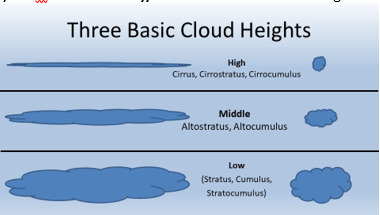Fact Box: Cloud Types and Classifications
- Clouds are classified based on their altitude and their visual characteristics.
- The system of cloud classification was first introduced by Lamarck in 1802, and Howard's system in 1803 became the foundation for the modern classification scheme.
- Clouds are categorized into three main altitude classes:
- Low-level clouds
- Mid-level clouds
- High-level clouds
- Each class is further divided into types based on characteristics such as shape and precipitation potential.
- The primary cloud types are Cirrus, Stratus, Cumulus, and Nimbus, each of which may have various subtypes.
Low-Level Clouds (Base: Below 6,500 ft)
- Cumulus Clouds (1,000 to 5,000 ft): These clouds form due to air rising from surface heating and may occasionally produce light showers. They are typically puffy and well-defined.
- Stratus Clouds (Surface to 2,000 ft (up to 4,000 ft in some cases)): These thick clouds can bring substantial precipitation, especially in coastal or hilly regions. They often obscure the sun but are still visible through thin patches.
- Stratocumulus Clouds (1,000 to 4,000 ft): These clouds can bring light precipitation, such as drizzle, especially in coastal or hilly areas. They may obscure the sun and are composed entirely of liquid drops.

- Cumulonimbus Clouds (2,000 to 5,000 ft (may vary)): These towering clouds result from deep convection, producing thunderstorms, hail, heavy showers, and squally winds. Their tops may extend to the tropopause, forming an anvil shape at their peak.
Mid-Level Clouds (Base: 6,500 to 20,000 ft)
- Altostratus Clouds (10,000 to 20,000 ft): Thicker altostratus clouds often produce light, continuous precipitation and obscure the sun. Thinner versions may allow the sun or moon to shine through with a glassy appearance.
- Altocumulus Clouds (6,500 to 20,000 ft): These clouds appear as broken patches in the sky and may produce light precipitation. They are sometimes thick enough to obscure the sun.
- Nimbostratus Clouds (Surface to 10,000 ft): These clouds produce continuous, moderate to heavy precipitation and always obscure the sun or moon.
High-Level Clouds (Base: Above 20,000 ft)
- Cirrus Clouds (20,000 to 40,000 ft): Composed entirely of ice particles, cirrus clouds do not produce precipitation but may create visual effects such as halos. They often signal the approach of weather fronts.
- Cirrostratus Clouds (20,000 to 40,000 ft): These thin, high-level clouds are known for creating halos around the sun or moon. They typically precede weather fronts and can thicken into lower clouds.
- Cirrocumulus Clouds (20,000 to 40,000 ft): These clouds are broken and usually do not produce precipitation. They allow the sun or moon to be visible and are often scattered across the sky.
Other Cloud Types
- Orographic Clouds: These clouds form as air is forced upward by elevated terrain. The cloud base varies but is often similar to low-level clouds. They may not produce significant precipitation, though larger systems can bring drizzle.
- Noctilucent Clouds (Altitude: ~280,000 ft (mesosphere)): The highest clouds, composed of water ice, are visible only after sunset when illuminated by light from below the horizon.
- Polar Stratospheric Clouds: Altitude is imilar to cirrus clouds in polar-regions. They are composed of ice particles, and are found in the stratosphere at high latitudes, particularly during the winter months.
|





